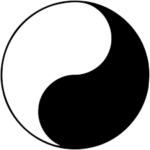
Yin Yang symbol
| Symbol | Yin Yang |
| Religion | Taoism |
| Origin | The symbol originated in ancient China, likely around the 3rd century BCE during the Warring States period. |
| Meaning | Represents the concept of dualism in Chinese philosophy, illustrating how seemingly opposite forces are interconnected and interdependent in the natural world. Yin represents the feminine, passive, and dark aspects, while Yang represents the masculine, active, and light aspects. The symbol embodies harmony, balance, and the cyclical nature of existence. |
| Appearance | The symbol consists of a circle divided into two halves by a curved line, with one half typically black (Yin) and the other white (Yang). Within each half, there is a smaller circle of the opposite color, symbolizing the presence of each within the other. |
| Colors | Traditionally depicted in black and white to represent the contrast between Yin and Yang. However, interpretations may vary, and sometimes other colors are used to convey additional meanings or nuances. |
| Usage | Widely used in various contexts, including philosophy, religion, martial arts, feng shui, and popular culture. It is often employed to convey concepts related to balance, harmony, and duality. |
| History | The symbol has a long history in Chinese culture, with roots in Taoist philosophy. It has been used for centuries to convey profound philosophical concepts and has become an integral part of Chinese cultural heritage. |
| Popularity | The Yin Yang symbol has gained widespread recognition and popularity worldwide, particularly in Western cultures, where it is often used in contexts related to spirituality, wellness, and holistic practices. |
| Importance | It holds significant importance in Taoist philosophy, serving as a fundamental concept that underpins various aspects of Chinese thought, including medicine, astrology, and martial arts. |
| Complexity | While the symbol itself appears simple, its meaning and implications are complex and multifaceted, reflecting the intricate balance and interplay of opposites in the universe. |
| Emotions | The symbol evokes a sense of balance, harmony, and interconnectedness, encouraging contemplation on the nature of existence and the relationship between opposing forces. |
The Yin Yang symbol, also known as the Taijitu, is a powerful and iconic image that represents the balance of opposing forces in the universe. It is a common symbol in Taoism, but it has also been adopted by many other cultures and philosophies.
The symbol consists of a circle divided into two halves by an S-shaped line. The black half is called yin, and it is associated with darkness, femininity, passivity, and receptivity. The white half is called yang, and it is associated with light, masculinity, activity, and penetration.
The most important thing to understand about the Yin Yang symbol is that yin and yang are not opposites, but rather complements. They are two sides of the same coin, and they are constantly interacting with and transforming into each other. This is represented in the symbol by the fact that each half contains a small dot of the opposite color.
The Yin Yang symbol is a reminder that everything in the universe is made up of both yin and yang. There is no such thing as pure yin or pure yang. Even in the darkest night, there is always a seed of light waiting to be born. And even in the brightest day, there is always a shadow lurking nearby.
The Yin Yang symbol is a powerful symbol of harmony and balance. It teaches us that we should not strive to eliminate the things we see as negative from our lives, but rather to embrace them as part of the whole. When we can do this, we can find peace and balance within ourselves and in our relationships with others.
Here are some additional facts about the Yin Yang symbol:
- The symbol is thought to have originated in ancient China around 3000 BCE.
- It is often used in traditional Chinese medicine to represent the balance of yin and yang in the body.
- The Yin Yang symbol has been adopted by many different cultures and religions around the world, including Hinduism, Buddhism, and New Age spirituality.